Biology
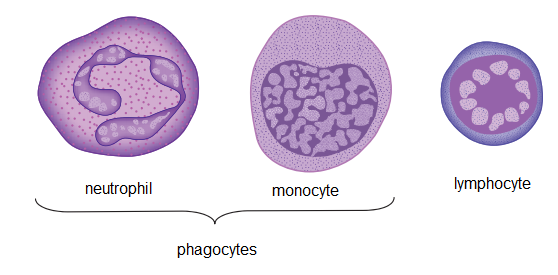 1 Phagocytes and lymphocytes are the cells of the immune system.
1 Phagocytes and lymphocytes are the cells of the immune system.
2 The diagram shows how to recognise phagocytes and lymphocytes in microscope slides and photomicrographs of blood.
3 Phagocytes originate in the bone marrow and are produced there throughout life. There are two types: neutrophils that circulate in the blood and enter infected tissues, and macrophages that remain inside tissues. They both destroy bacteria and viruses by phagocytosis.
4 Antigens are ?foreign? (non-self) macromolecules that stimulate the immune system.
5 Lymphocytes also originate in bone marrow. There are two types: B-lymphocytes (B cells) and T-lymphocytes (T cells). As they mature, B cells and T cells gain glycoprotein receptors that are specific to each cell. Each cell divides to form a small clone of cells that spreads throughout the body in the blood and in the lymphoid tissue (e.g. lymph nodes and spleen).
6 B cells mature in bone marrow. T cells mature in the thymus gland. During maturation, many T cells are destroyed, as they express receptors that interact with self-antigens. If left to circulate in the body, they would destroy cells and tissues. The T cells that are not destroyed recognise non-self antigens, such as those on the surfaces of pathogens.
7 During an immune response, those B and T cells that have receptors specific to the antigen are
activated.
8 When B cells are activated they form plasma cells which secrete antibodies.
9 T cells do not secrete antibodies; their surface receptors are similar to antibodies and identify
antigens. They develop into either T helper cells or killer T cells (cytotoxic T cells). T helper cells
secrete cytokines that control the immune system, activating B cells and killer T cells, which kill
infected host cells.
10 During an immune response, memory cells are formed which retain the ability to divide rapidly and develop into active B or T cells on a second exposure to the same antigen (immunological memory). The diagram on the next page summarises the actions of B cells and T cells during an immune response.
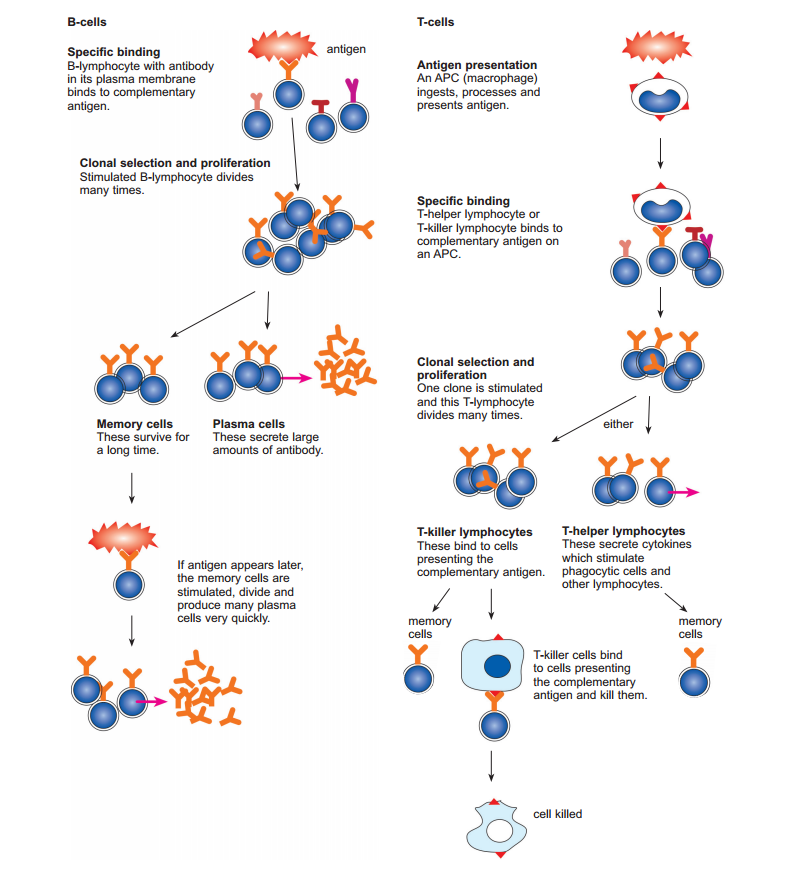
11 Antibodies are globular glycoproteins. They all have one or more pairs of identical heavy polypeptides and of identical light polypeptides. Each type of antibody interacts with one antigen via the specific shape of its variable region. Each molecule of the simplest antibody (IgG) can bind to two antigen molecules. Larger antibodies (IgM and IgA) have more than two antigen-binding sites.
12 Antibodies agglutinate bacteria, prevent viruses infecting cells, coat bacteria and viruses to aid
phagocytosis, act with plasma proteins to burst bacteria, and neutralise toxins.
13 Active immunity is the production of antibodies and active T cells during a primary immune response to an antigen acquired either naturally by infection or artifi cially by vaccination. This gives permanent immunity.
14 Passive immunity is the introduction of antibodies either naturally across the placenta or in breast milk, or artifi cially by injection. This gives temporary immunity.
15 Vaccination confers artificial active immunity by introducing a small quantity of an antigen by
injection or by mouth. This may be a whole living organism, a dead one, a harmless version of a toxin (toxoid) or a preparation of antigens.
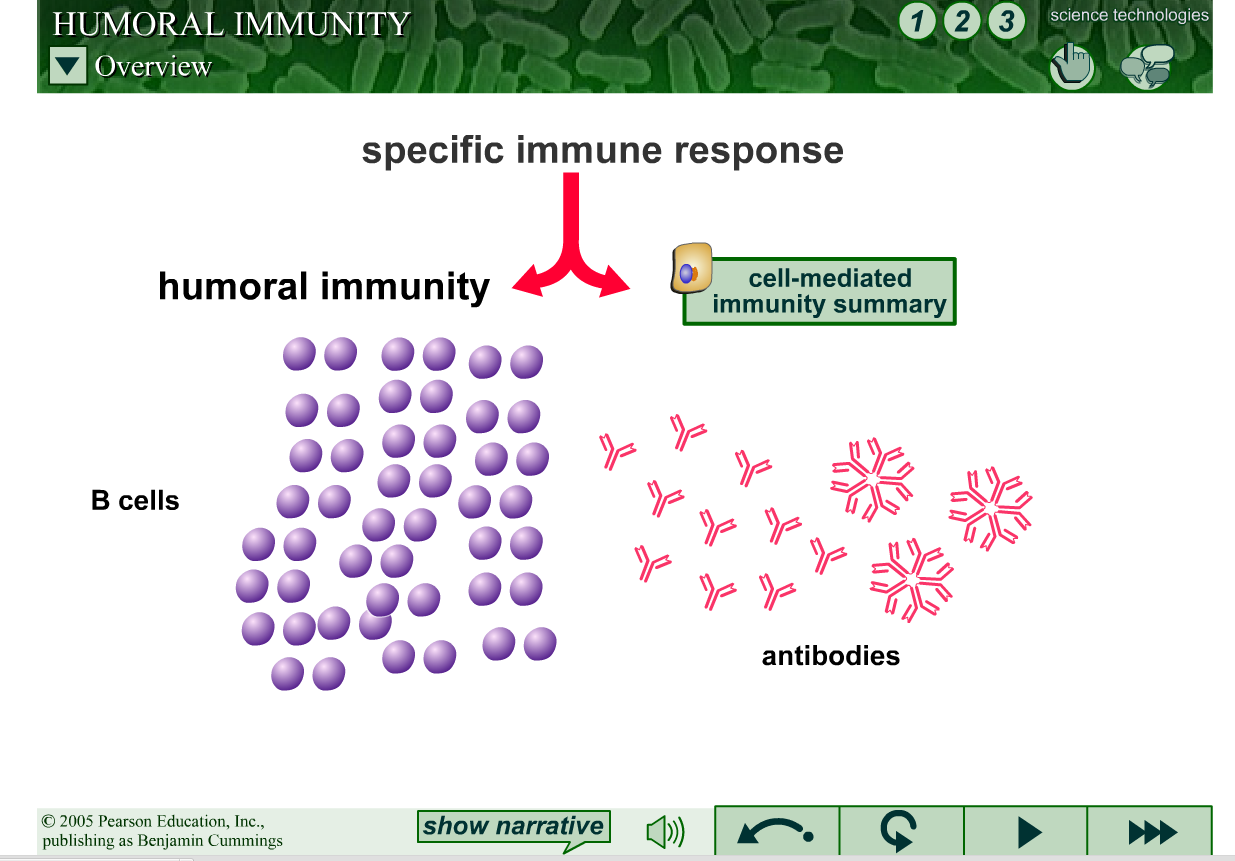
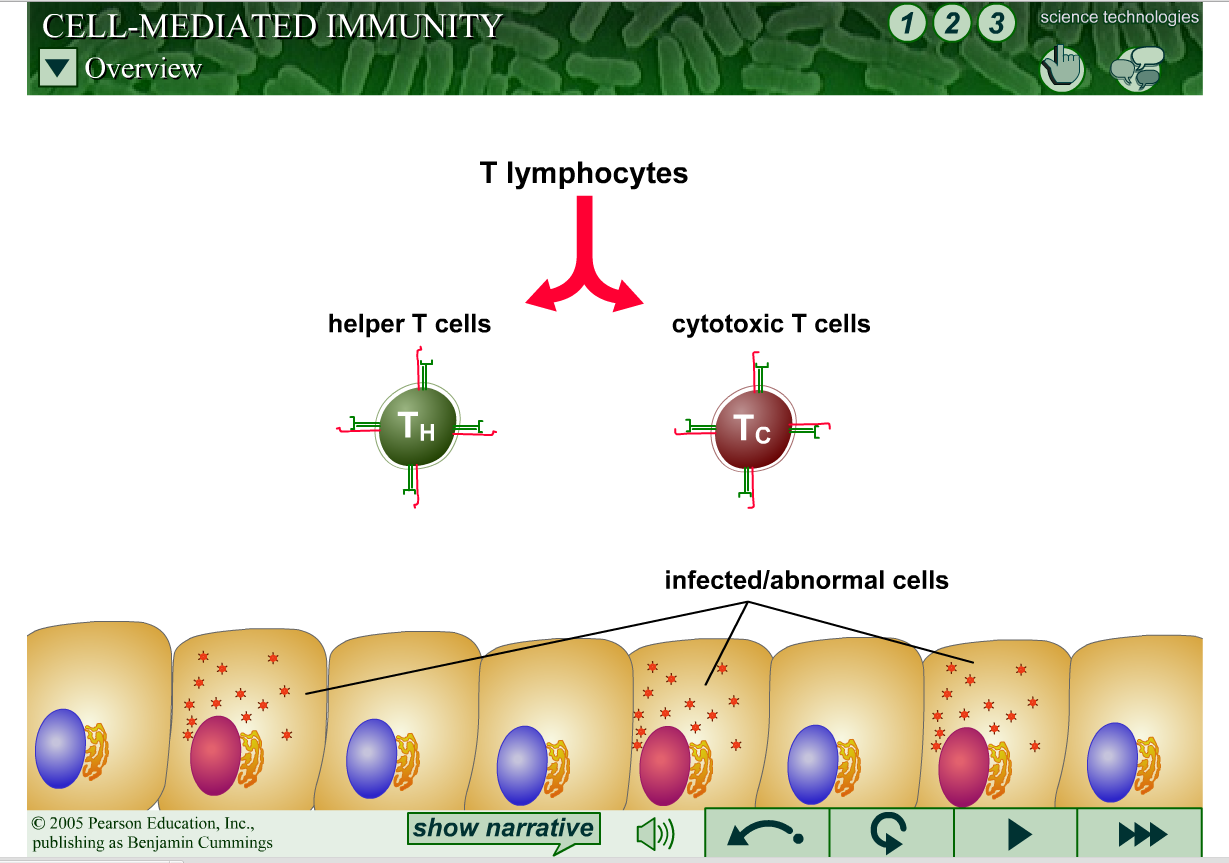
1. Multiple-choice test
1 What are produced from a B-lymphocyte?
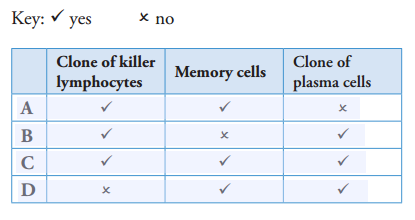
4 Which of the following describes an antigen?
A binds to a molecule that can stimulate an immune response
B binds with a non-self protein
C does not stimulate an immune response inside the body that produced it
D stimulates an immune response when recognised as non-self
5 Newborn babies acquire immunity from their mothers.
Why is this immunity only temporary?
A no memory cells are produced by the baby
B not enough antibodies are produced
C the antibodies act only in the mother
D the immunity is not inherited
6 The statements describe molecular structure.
1 an insoluble fibrous glycoprotein
2 has quaternary structure held together by disulfide bonds
3 has two identical binding sites
4 made up of two longer and two shorter chains
Which statements describe an antibody molecule?
A 1, 2, 3 and 4
B 1, 2 and 3 only
C 2, 3 and 4 only
D 3 and 4 only
7 An individual?s immunity may result from:
1 having memory cells after an infection
2 having memory cells after being injected with dead bacteria
3 being injected with antibodies
4 receiving antibodies from breast milk.
Which row shows an example of the different types of immunity?

8 The drawing shows some blood cells.
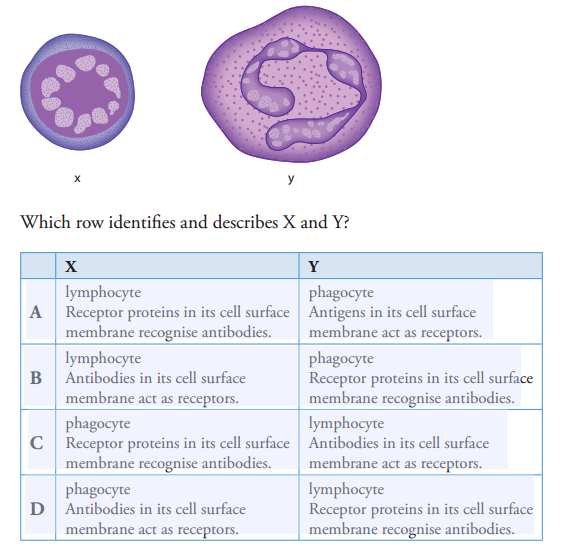
9 The statements are about the role of a phagocyte.
1 bacteria in phagocytic vacuole
2 hydrolysis of bacteria
3 phagocyte attracted to bacteria
4 bacteria taken into phagocyte by endocytosis
5 fusion of lysosomes with phagocytic vacuole
Which of the following shows the sequence of events after antibodies have become attached to a pathogenic bacterium?
A 1 ? 5 ? 2 ? 3 ? 4
B 3 ? 4 ? 1 ? 5 ? 2
C 4 ? 1 ? 3 ? 5 ? 2
D 5 ? 2 ? 3 ? 4 ? 1
10 The statements describe lymphocytes.
1 Each B-lymphocyte can make only one type of antibody.
2 Both B-lymphocytes and T-lymphocytes circulate in the blood and lymph.
3 Some T-lymphocytes stimulate B-lymphocytes to divide.
4 B-lymphocytes can develop into plasma cells and secrete antibodies.
5 Some T-lymphocytes kill any of the body?s cells that are infected with pathogens.
Which statements are correct?
A 1, 2, 3, 4 and 5
B 1, 2, 3 and 4 only
C 2, 3 and 4 only
D 3, 4 and 5 only
Answers to Multiple choice test
- # 62 Immunity And Vaccination
A person is immune to a disease if the pathogen that causes the disease is unable to reproduce in the body and cause illness. This happens when the body already contains, or is able rapidly to make, large quantities of antibodies against the antigens...
- # 61 Action Of T-lymphocytes
T-lymphocytes include T helper cells and T killer cells. Both of these types of cell place their specific receptors in their cell surface membranes. On encountering the relevant antigen, they are activated and divide by mitosis to form...
- # 60 Action Of B-lymphocytes
A B-lymphocyte places some of its specific receptor molecules in its cell surface membrane. If it encounters an antigen that binds with this receptor, the B-lymphocyte is activated. It divides repeatedly by mitosis to produce a clone of genetically identical plasma...
- #57 Immunity - Syllabus 2015
? The immune system ? Vaccination Candidates should be able to: (a) [PA] recognise phagocytes and lymphocytes under the light microscope; (b) state the origin and describe the mode of action of phagocytes (macrophages and neutrophils); (c) describe...
- Immunity And Immune System
IMMUNE SYSTEM It is the system that gives immunity to the body by recognizing, responding and remembering foreign antigens. It plays role in allergic reaction, auto-immune disease and organ transplantation. It includes lymphoid organs, tissues, cells...
Biology
# 63 Summary of Immunity
 1 Phagocytes and lymphocytes are the cells of the immune system.
1 Phagocytes and lymphocytes are the cells of the immune system.2 The diagram shows how to recognise phagocytes and lymphocytes in microscope slides and photomicrographs of blood.
3 Phagocytes originate in the bone marrow and are produced there throughout life. There are two types: neutrophils that circulate in the blood and enter infected tissues, and macrophages that remain inside tissues. They both destroy bacteria and viruses by phagocytosis.
4 Antigens are ?foreign? (non-self) macromolecules that stimulate the immune system.
5 Lymphocytes also originate in bone marrow. There are two types: B-lymphocytes (B cells) and T-lymphocytes (T cells). As they mature, B cells and T cells gain glycoprotein receptors that are specific to each cell. Each cell divides to form a small clone of cells that spreads throughout the body in the blood and in the lymphoid tissue (e.g. lymph nodes and spleen).
6 B cells mature in bone marrow. T cells mature in the thymus gland. During maturation, many T cells are destroyed, as they express receptors that interact with self-antigens. If left to circulate in the body, they would destroy cells and tissues. The T cells that are not destroyed recognise non-self antigens, such as those on the surfaces of pathogens.
7 During an immune response, those B and T cells that have receptors specific to the antigen are
activated.
8 When B cells are activated they form plasma cells which secrete antibodies.
9 T cells do not secrete antibodies; their surface receptors are similar to antibodies and identify
antigens. They develop into either T helper cells or killer T cells (cytotoxic T cells). T helper cells
secrete cytokines that control the immune system, activating B cells and killer T cells, which kill
infected host cells.
10 During an immune response, memory cells are formed which retain the ability to divide rapidly and develop into active B or T cells on a second exposure to the same antigen (immunological memory). The diagram on the next page summarises the actions of B cells and T cells during an immune response.

11 Antibodies are globular glycoproteins. They all have one or more pairs of identical heavy polypeptides and of identical light polypeptides. Each type of antibody interacts with one antigen via the specific shape of its variable region. Each molecule of the simplest antibody (IgG) can bind to two antigen molecules. Larger antibodies (IgM and IgA) have more than two antigen-binding sites.
12 Antibodies agglutinate bacteria, prevent viruses infecting cells, coat bacteria and viruses to aid
phagocytosis, act with plasma proteins to burst bacteria, and neutralise toxins.
13 Active immunity is the production of antibodies and active T cells during a primary immune response to an antigen acquired either naturally by infection or artifi cially by vaccination. This gives permanent immunity.
14 Passive immunity is the introduction of antibodies either naturally across the placenta or in breast milk, or artifi cially by injection. This gives temporary immunity.
15 Vaccination confers artificial active immunity by introducing a small quantity of an antigen by
injection or by mouth. This may be a whole living organism, a dead one, a harmless version of a toxin (toxoid) or a preparation of antigens.
Animation
Humoral immunity

Cell-mediated immunity

1. Multiple-choice test
1 What are produced from a B-lymphocyte?

2 What is the function of plasma cells during an immune response?
A to become memory cells
B to ingest invading bacteria
C to kill cells infected with viruses
D to secrete antibodies
A to become memory cells
B to ingest invading bacteria
C to kill cells infected with viruses
D to secrete antibodies
3 After an immune response, memory cells remain in the blood for a long time.
What is the function of a memory cell?
A to divide to make plasma cells
B to ingest invading bacteria
C to kill cells infected with viruses
D to secrete antibodies
What is the function of a memory cell?
A to divide to make plasma cells
B to ingest invading bacteria
C to kill cells infected with viruses
D to secrete antibodies
4 Which of the following describes an antigen?
A binds to a molecule that can stimulate an immune response
B binds with a non-self protein
C does not stimulate an immune response inside the body that produced it
D stimulates an immune response when recognised as non-self
5 Newborn babies acquire immunity from their mothers.
Why is this immunity only temporary?
A no memory cells are produced by the baby
B not enough antibodies are produced
C the antibodies act only in the mother
D the immunity is not inherited
6 The statements describe molecular structure.
1 an insoluble fibrous glycoprotein
2 has quaternary structure held together by disulfide bonds
3 has two identical binding sites
4 made up of two longer and two shorter chains
Which statements describe an antibody molecule?
A 1, 2, 3 and 4
B 1, 2 and 3 only
C 2, 3 and 4 only
D 3 and 4 only
7 An individual?s immunity may result from:
1 having memory cells after an infection
2 having memory cells after being injected with dead bacteria
3 being injected with antibodies
4 receiving antibodies from breast milk.
Which row shows an example of the different types of immunity?

8 The drawing shows some blood cells.

9 The statements are about the role of a phagocyte.
1 bacteria in phagocytic vacuole
2 hydrolysis of bacteria
3 phagocyte attracted to bacteria
4 bacteria taken into phagocyte by endocytosis
5 fusion of lysosomes with phagocytic vacuole
Which of the following shows the sequence of events after antibodies have become attached to a pathogenic bacterium?
A 1 ? 5 ? 2 ? 3 ? 4
B 3 ? 4 ? 1 ? 5 ? 2
C 4 ? 1 ? 3 ? 5 ? 2
D 5 ? 2 ? 3 ? 4 ? 1
10 The statements describe lymphocytes.
1 Each B-lymphocyte can make only one type of antibody.
2 Both B-lymphocytes and T-lymphocytes circulate in the blood and lymph.
3 Some T-lymphocytes stimulate B-lymphocytes to divide.
4 B-lymphocytes can develop into plasma cells and secrete antibodies.
5 Some T-lymphocytes kill any of the body?s cells that are infected with pathogens.
Which statements are correct?
A 1, 2, 3, 4 and 5
B 1, 2, 3 and 4 only
C 2, 3 and 4 only
D 3, 4 and 5 only
Answers to Multiple choice test
1. D
2. D
3. A
4. D
5. A
6. C
7. B
8. B
9. B
10. A
10. A
2. End-of-chapter questions


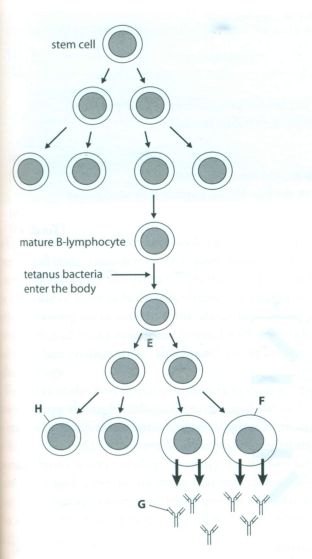
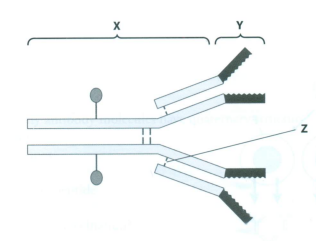
1 C
2 D
3 D
4 A
Exam-style questions

5 a i bone marrow; [1]
ii mitosis; [1]
iii plasma cell; [1]
iv antibody; [1]
b i antigen refers to any substance that stimulates the production of antibodies; antibodies are proteins produced by, plasma cells/(activated) B-lymphocytes; each antibody is specific to an antigen; [3]
ii self refers to antigen(s) within a person?s body (e.g. those of the ABO blood group system which they have); all the antigens that the immune system does not recognise as foreign; [max. 1]
non-self refers to antigen(s) that are not in a person?s body (e.g. those of, pathogens/the ABO system, that they do not have); all the antigens that the immune system recognises as foreign; [max. 1]
c memory cell;
remains in circulation/lymph system/body;
is specific to an antigen on tetanus bacteria;
responds quickly to another infection by (same strain of) pathogen;
as there are a large number/is a large clone;
during (secondary/subsequent) immune response;
differentiate into plasma cells;
to give large number of antibody molecules in short space of time; [max. 3]
6 a phagocyte has lobed nucleus;
lysosomes;
larger quantity of cytoplasm; [3]
Reject statement that phagocyte is larger, as question asks for diff erences in structure, not size.
b presentation of antigen(s) by macrophages/other APCs;
some T-lymphocytes have receptors complementary to antigen;
these are selected;
divide by mitosis;
helper T cells secrete cytokines;
to activate B-lymphocytes;
to secrete antibodies;
killer T cells search for cells infected by, parasite/ pathogen;
destroy host cell (and pathogen);
prevent reproduction of pathogen; [max. 6]
c B-lymphocytes can be activated by presence of, antigen/pathogen alone;
without involvement of macrophages;
B-lymphocytes diff erentiate into plasma cells;
secrete antibodies (T cells do not secrete antibodies); [max. 2]
7 a i immunity is gained by the transfer of antibodies from another source;
no immune response within the body;
antigen(s)/pathogen(s),
have not entered the body; [max. 2]
ii natural passive immunity: antibodies cross the placenta;
in breast milk/colostrum; [max. 1]
b i baby has passive immunity;
antibodies against measles antigens (from mother) will interact with measles viruses/ antigens in vaccine;
so prevent an immune response;
therefore no memory cells will be formed; [max. 3]
ii difficulty with timing first vaccination;
many children are not vaccinated at appropriate time;
measles is highly infectious;
vaccination programmes concentrated on other infectious diseases which have more severe effect, such as smallpox and polio; [max. 3]
c herd/mass vaccination/immunity;
prevented spread through population;
surveillance for infected people;
very easy to identify infected people/no symptomless carriers;
contact tracing to fi nd people who may have become infected; ring vaccination/vaccination of all people in surrounding area;
prevented spread from isolated infected people;
one dose of the vaccine was enough to give lifelong immunity/no boosters required;
vaccine contained ?live? virus;
smallpox virus was stable/did not mutate;
no antigenic variation;
same vaccine was used for whole programme/did not need to be changed; heat-stable/freeze-dried, vaccine;
suitable for hot countries/isolated areas/rural areas;
bifurcated/steel, needle made vaccinating easy;
did not need to be done by health professionals; [max. 6]
8 a transcription (of DNA);
translation (of RNA);
assembly of amino acids to make four polypeptides;
assembly of polypeptides to make antibody molecule;
packaged in Golgi body into vesicles;
exocytosis; [max. 4]
b i X = variable region/antigen-binding site; Y = constant region; [2]
ii disulfide; [1]
c variable region(s) are antigen-binding sites;
variable regions, are specific/complementary, to antigen;
variable region has diff erent amino acid sequences for diff erent antigens;
20 different amino acids can be arranged to form diff erent shapes;
disulfide bonds hold polypeptides together;
hinge region allows flexibility in binding to antigen;
constant region for binding to receptors on phagocytes; [max. 4]
1 A student made drawings of four blood cells shown in the figure.

The correct identification of the cellsis:

2 The following occur during the response to infection.
1 bacteria attach to cell surface membrane of phagocyte
2 movement of phagocyte to site of infection by bacteria
3 formation of a phagocytic vacuole
4 fusion of lysosomes to the phagocytic vacuole
5 infolding of cell surface membrane
6 release of enzymes into the phagocytic vacuole
In which order do these events occur?
A 1,2,3,4,6,5
B 1,2,3,5,4,6
C 2, 1, 3, 6, 5,4
D 2, 1,5,3,4,6
3 Which of the following explains why antibody molecules have quaternary structure?
A antibodies have a variable region
B antibodies have complex 3D shapes
C antibodies have four polypeptides
D antibodies have more than one polypeptide
4 Which type of immunity is provided by vaccination?
A artificial active
B artificial passive
C natural active
D natural passive
5 Tetanus is a bacterial disease that may be acquired during accidents in which a wound is exposed to the soil.
B-lymphocytes originate from stem cells, mature and circulate around the body. Following infection by tetanus bacteria, some B-lymphocytes will become activated as shown in the figure.

a With reference to the figure, name:
i the place where the stem cells divide to form B-lymphocytes [1]
ii the type of division that occurs at E [1]
iii the activated B-Iymphocyte, F [1]
iv the molecule G. [1]
b Use the information in the figure to explain the differences between the following pairs of terms:
i antigen and antibody [3]
ii self and non-self [2]
c Explain how cell H is responsible for long-term immunity to tetanus. [3]
[Total: 12]
6 Phagocytes and lymphocytes are both present in samples of blood.
a Describe how the structure of a phagocyte differs from the structure of a lymphocytes. [3]
T-lymphocytes are involved in immune responses to pathogens that invade the body. Immune responses involve the following:
? antigen presentation
? clonal selection
? clonal expansion
Certain groups of T-lymphocytes are activated when the body is infected with the measles virus.
b Using the information above, describe what happens to T-lymphocytes during an immune response to measles. [6]
c Statehow the response of B-lymphocytes during an immune response is different to the response of T-lymphocytes. [2]
[Total: 11]
7 Measles is a common viral infection. Babies gain passive immunity to measles.
a Explain:
i the term passive immunity
ii how babies gain passive immunity.
A vaccine for measles has been available since the 1960s. Global vaccination programmes include providing vaccination for measles, but it is important that the vaccine is not given to babies too early.
b Explain why:
i the vaccine for measles should not be given too early [3]
ii measles has not been eradicated, even though a vaccine has existed since the 1960s.
c Smallpox was an infectious disease that was finally eradicated in the late 1970s. Explain how vaccination was used in the eradication of smallpox.
[Total: 15]
8 The figure is a diagram of an antibody molecule.

a Describe briefly how antibody molecules are produced and secreted. [4]
b Name:
i the regions X and Y
ii the bond labelled z.
c Explain how the structure of an antibody is related to its function.
[Total: 11]
3. End-of-chapter answers
2 D
3 D
4 A
Exam-style questions

5 a i bone marrow; [1]
ii mitosis; [1]
iii plasma cell; [1]
iv antibody; [1]
b i antigen refers to any substance that stimulates the production of antibodies; antibodies are proteins produced by, plasma cells/(activated) B-lymphocytes; each antibody is specific to an antigen; [3]
ii self refers to antigen(s) within a person?s body (e.g. those of the ABO blood group system which they have); all the antigens that the immune system does not recognise as foreign; [max. 1]
non-self refers to antigen(s) that are not in a person?s body (e.g. those of, pathogens/the ABO system, that they do not have); all the antigens that the immune system recognises as foreign; [max. 1]
c memory cell;
remains in circulation/lymph system/body;
is specific to an antigen on tetanus bacteria;
responds quickly to another infection by (same strain of) pathogen;
as there are a large number/is a large clone;
during (secondary/subsequent) immune response;
differentiate into plasma cells;
to give large number of antibody molecules in short space of time; [max. 3]
[Total: 12]
6 a phagocyte has lobed nucleus;
lysosomes;
larger quantity of cytoplasm; [3]
Reject statement that phagocyte is larger, as question asks for diff erences in structure, not size.
b presentation of antigen(s) by macrophages/other APCs;
some T-lymphocytes have receptors complementary to antigen;
these are selected;
divide by mitosis;
helper T cells secrete cytokines;
to activate B-lymphocytes;
to secrete antibodies;
killer T cells search for cells infected by, parasite/ pathogen;
destroy host cell (and pathogen);
prevent reproduction of pathogen; [max. 6]
c B-lymphocytes can be activated by presence of, antigen/pathogen alone;
without involvement of macrophages;
B-lymphocytes diff erentiate into plasma cells;
secrete antibodies (T cells do not secrete antibodies); [max. 2]
[Total: 11]
7 a i immunity is gained by the transfer of antibodies from another source;
no immune response within the body;
antigen(s)/pathogen(s),
have not entered the body; [max. 2]
ii natural passive immunity: antibodies cross the placenta;
in breast milk/colostrum; [max. 1]
b i baby has passive immunity;
antibodies against measles antigens (from mother) will interact with measles viruses/ antigens in vaccine;
so prevent an immune response;
therefore no memory cells will be formed; [max. 3]
ii difficulty with timing first vaccination;
many children are not vaccinated at appropriate time;
measles is highly infectious;
vaccination programmes concentrated on other infectious diseases which have more severe effect, such as smallpox and polio; [max. 3]
c herd/mass vaccination/immunity;
prevented spread through population;
surveillance for infected people;
very easy to identify infected people/no symptomless carriers;
contact tracing to fi nd people who may have become infected; ring vaccination/vaccination of all people in surrounding area;
prevented spread from isolated infected people;
one dose of the vaccine was enough to give lifelong immunity/no boosters required;
vaccine contained ?live? virus;
smallpox virus was stable/did not mutate;
no antigenic variation;
same vaccine was used for whole programme/did not need to be changed; heat-stable/freeze-dried, vaccine;
suitable for hot countries/isolated areas/rural areas;
bifurcated/steel, needle made vaccinating easy;
did not need to be done by health professionals; [max. 6]
[Total: 15]
8 a transcription (of DNA);
translation (of RNA);
assembly of amino acids to make four polypeptides;
assembly of polypeptides to make antibody molecule;
packaged in Golgi body into vesicles;
exocytosis; [max. 4]
b i X = variable region/antigen-binding site; Y = constant region; [2]
ii disulfide; [1]
c variable region(s) are antigen-binding sites;
variable regions, are specific/complementary, to antigen;
variable region has diff erent amino acid sequences for diff erent antigens;
20 different amino acids can be arranged to form diff erent shapes;
disulfide bonds hold polypeptides together;
hinge region allows flexibility in binding to antigen;
constant region for binding to receptors on phagocytes; [max. 4]
[Total: 11]
- # 62 Immunity And Vaccination
A person is immune to a disease if the pathogen that causes the disease is unable to reproduce in the body and cause illness. This happens when the body already contains, or is able rapidly to make, large quantities of antibodies against the antigens...
- # 61 Action Of T-lymphocytes
T-lymphocytes include T helper cells and T killer cells. Both of these types of cell place their specific receptors in their cell surface membranes. On encountering the relevant antigen, they are activated and divide by mitosis to form...
- # 60 Action Of B-lymphocytes
A B-lymphocyte places some of its specific receptor molecules in its cell surface membrane. If it encounters an antigen that binds with this receptor, the B-lymphocyte is activated. It divides repeatedly by mitosis to produce a clone of genetically identical plasma...
- #57 Immunity - Syllabus 2015
? The immune system ? Vaccination Candidates should be able to: (a) [PA] recognise phagocytes and lymphocytes under the light microscope; (b) state the origin and describe the mode of action of phagocytes (macrophages and neutrophils); (c) describe...
- Immunity And Immune System
IMMUNE SYSTEM It is the system that gives immunity to the body by recognizing, responding and remembering foreign antigens. It plays role in allergic reaction, auto-immune disease and organ transplantation. It includes lymphoid organs, tissues, cells...
